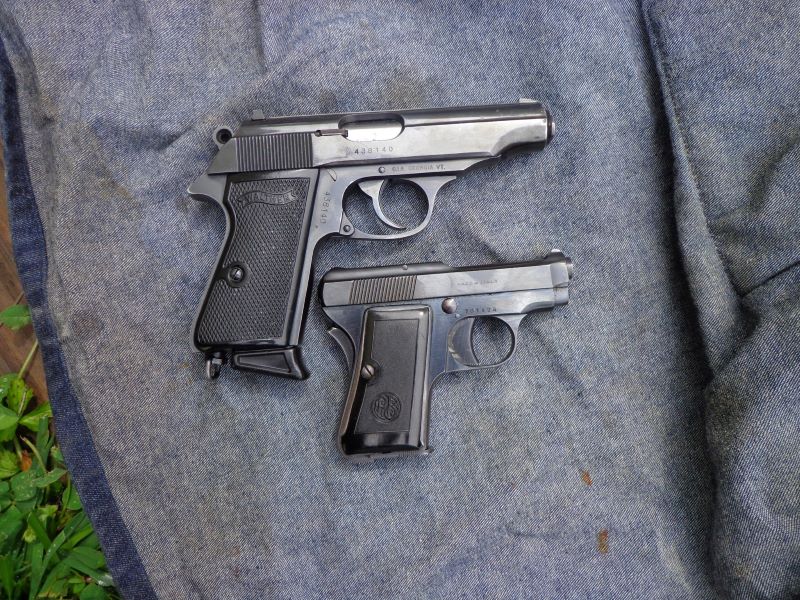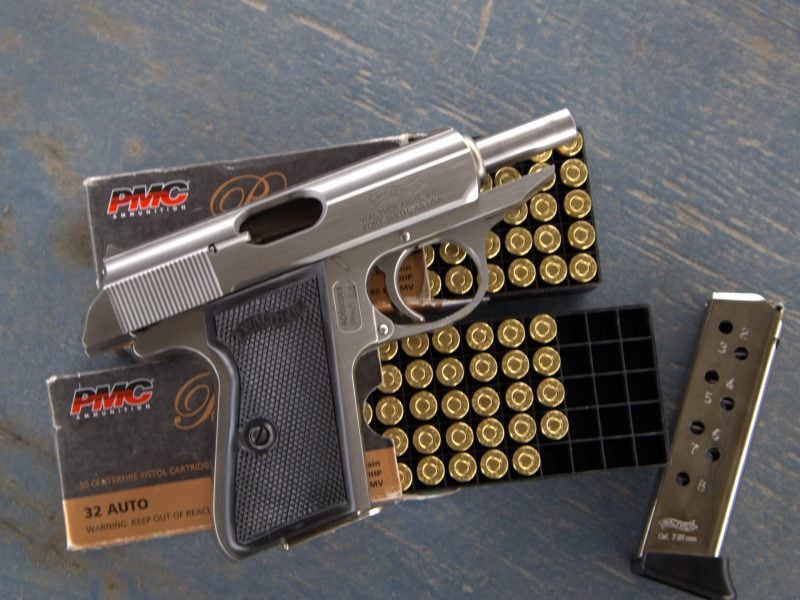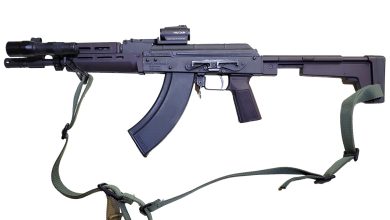Cartridges in .32 caliber come and go and come back again. Some come on strong and then fade, and others never quite hit the mark. But none truly die away, and there is a good reason for that. Although small by today’s standards, .32 caliber cartridges have the benefits of reliability and power over .22 rimfire but with much of the same recoil or kickback as the latter. The .32 also has the benefit of being chambered in diminutive pistols with no loss in control.
In short, the .32 is efficient. .32s are a niche round making something of a comeback today, but if we rewind the lock, these rounds were the de facto defensive rounds of their time. Indeed, entire platforms would not have gotten off the ground without them. Case in point is the .32 ACP. The .32 ACP is encountered sparingly today, yet it is a round by many names and is denoted as a round that started one world war and ended a second. But more consequential is the fact that the .32 ACP legitimized the semi-automatic pistol as a defensive and military option. Further, it is an efficient round for personal protection.

.32 ACP: What came before?
These smaller caliber guns needed smaller barrels, smaller cylinders, and smaller firing mechanisms to work with. Let’s take Colt as an example. In the 19th century, Colt manufactured a number of legendary big-bore handguns like the 1851 Navy, 1860 Army, and 1873 Peacemaker. But the company’s bestselling gun for that century was the 1849 Pocket Model, which fired a .32 caliber bullet.
That popularity translated over to cartridges. .22 rimfire guns were around in pistols like the S&W No. 1, but .32 caliber rimfire and centerfire guns were even more popular. For every big bore .44 or .45, many more .32 caliber revolvers and derringers were sold. At the turn of the century, Colt, Smith & Wesson, Iver Johnson, and Hopkins & Allen dominated the concealed carry market with small revolvers chambered in .32.
The most popular cartridge was the .32 S&W. This rimmed revolver cartridge was fed by a few grains of black powder and hurled an 88-grain bullet at about 650 feet per second. .32 S&W is grossly underpowered today, but at the time, it was considered sufficient. The invention of the semi-auto pistol marked a transition from that round to the .32 ACP.
The .32 ACP and the Browning Model 1899
Often, a cartridge is born before the gun. But in this case, the .32 ACP was developed after the semi-auto pistol beyond a proof of concept. It would make the semi-auto explode onto the scene.
In 1893, the Borchardt automatic pistol hit the market. This toggle action monstrosity fed from a detachable box magazine and reloaded itself using the recoil force of the ammunition. It was ungainly and fired the 7.62 Borchardt cartridge, one too powerful for something that could go into a conventional handgun. Indeed, the Borchardt was probably best suited with its optional shoulder stock. But this model set the gears in motion to produce something more practical. Luger sought to simply the Borchardt directly, while Mauser had its own construction in the C96. John Browning had the idea of a slide-actuated pistol and created the .32 ACP cartridge to suit that design, which would become the Browning Model 1899.


The Design Takes Hold
The .32 ACP had a smaller rim than the .32 S&W but was a smokeless cartridge and used a full metal jacket bullet, all of which made it more practical for an auto pistol. It also happened to be more powerful, but not so powerful that it could not be used in Browning’s pistol. The M1899 had a fixed barrel and relied on slide weight and spring pressure to cycle. It was a simple blowback design, yet it worked well. After some internal improvements, the M1900 entered production with FN in Belgium. The new pistol’s decent power, eight-round capacity, and ability to get quick follow-up shots endeared it to ordinance officers throughout Europe.
Although Luger holds the distinction of having his semi-auto pistol adopted first by the Swiss in 1900, the Belgians had the M1900 in a matter of months. The M1900 would go on to be adopted by a number of other European nations, including Greece and Serbia.
Browning’s pistols also fell into the hands of militant groups fomenting unrest through protest, crime, and assassination. Serbia covertly procured several Browning pistols for use by the nationalist Black Hand. Tragically for the world, the Black Hand successfully targeted Archduke Franz Ferdinand of Austria-Hungary in the summer of 1914, sparking the First World War. The teenage assassin, Gavrilo Princip, was alleged to have used a Browning M1900 in .32 ACP, but the actual pistol was the newer M1910 in the then-new .380 ACP cartridge.
Growing Popularity
Nonetheless, the .32 ACP’s popularity grew with the war years as pistols became more instrumental in the trench fighting that characterized the war. It also happened to be the most popular round at the time, and demand for arms could be satisfied. Small Pieper, Browning, and Mauser .32 ACP satisfied German demand, while the French opted to import huge quantities of Ruby pistols from Spain.
The sheer number of .32 caliber revolvers on the market in the US kept demand for the new .32 ACP at a low ebb, but not enough for fabled handguns like the Colt Model 1903 to make their debut. Another interesting design is the Savage Model 1907. Savage ultimately failed to beat Colt in the 1911 pistol trials, but they found success with their smaller double-stack Model 1907 in .32 ACP. Despite the relative success of these models, the .32 ACP would not find much popularity.
World War II and the Decline of the .32 ACP


Although the 9mm Luger became more popular in military circles after the First World War, the .32 ACP continued to thrive as a concealable pistol option for staff officers and as a sidearm for policemen. World War II saw the .32 ACP on both sides of the conflict. The US Army’s general officer’s sidearm was the Model 1903 in place of the heavier Model 1911 in .45.
The British adapted the subsonic .32 ACP for its suppressed Welrod pistol. However, the .32 ACP was most commonly fielded by Europe’s combatants. The Walther PP and PPK feature prominently on the German side. Although not standard military issue, these pistols were the latest in police gear and a favorite of party officials and front-line officers alike.
Postwar Service
After the war, the .32 ACP cartridge continued in police service in a divided Europe. Western Europe turned away from it completely after the 1972 Munich Hostage Crisis forced a reevaluation of police gear and tactics. In the Communist bloc, PPK-like pistols in 9×18 Makarov were military issue, and handguns like the CZ-50 and PA-63 in .32 ACP were still common in police work until the Berlin Wall fell.


Veteran bringbacks of Sauer, Walther, and Mauser pistols led to some renewed interest in the US in the .32, but it remained a niche cartridge like .25 ACP and .380 ACP. As shall-issue carry laws began to be passed in the 1990s, the .380 remained the bigger bore round that could be chambered in simpler blowback-operated pistols and, later, small polymer-framed locked-breech pistols.
The Modern Era
In 1999, KelTec debuted the P32. This single-stack polymer framed pocket pistol is as small and light as any pistol and is the oldest in Keltec’s lineup. Yet the P3AT in .380 debuted a few years later and led to a spat of .380 designs that have dominated the market. Today, the .32 ACP is the bane of older handguns, save for a few holdouts. These include the P32 and Beretta Tomcat. Also among them is the Seecamp LWS 32 and its copy, the NAA Guardian. In 2024, Walther reintroduced the PPK/s in .32 ACP. All major manufacturers continue to make loadings for the .32 ACP, but both the ammunition and the available firearms live in the shadow of the bigger .380.


The .32 ACP Today: Pros and Cons
The cartridge never really caught on in the United States, and part of it was likely the sheer number of competing options on the market. But there are some good reasons to pick the round for carry, as well as some aspects of the round that might guide you to steer clear.
The .32 ACP is a low-pressure round capable of chambering in the most diminutive pistols. It is also centerfire, which is more reliable than smaller .22 rimfire rounds you might encounter in pocket guns. But that capability is seldom realized. The Seecamp remains one of the smallest handguns on the market, but it also has a dated all-steel design.
Viable Options
The ultimate .32 might be the KelTec P32, which boasts a polymer frame and weighs under 9 ounces. Otherwise, the .32 is going to be encountered in even older and larger frame designs like the Walther PPK. These designs are deceptively easy to shoot and shoot well, as their all-metal frames soak up what little recoil the .32 produces. In general, the .32 recoils considerably less than comparable pistols in .380.
While the .32 has the potential to make for a very small carry package or a very shootable one, the cartridge itself has its own limitations. .32 is considered somewhat small by today’s standards, and .32 ACP is slower compared to more recent .32 caliber rounds like the .32 H&R Magnum and .327 Federal Magnum revolver cartridges. Buffalo Bore, Underwood, and Corbon have come to the rescue with high-velocity loadings for the .32, but most .32 ACP loadings consist of either a 60-grain hollow point or a 71-grain full metal jacket bullet traveling no faster than 900 feet per second.


Conventional wisdom states that numbers this low are too low for hollow-point expansion, and shooters are best advised to use the old-school full metal jacket to ensure good penetration should a hollow-point expand and not penetrate enough.
Although it has the virtue of being centerfire, the .32 ACP sacrifices some potential reliability because it has a rimmed case. Most of the first-generation auto pistol cartridges come with a small rim that will work well with a magazine but be reliable in terms of extraction. Later rounds, like the 9mm Luger, have rimless or rebated rims that are flush with the case. Like .22 LR or .25 ACP, it is possible to load the magazine of a .32 ACP pistol with the rim of one round overlapping with the rim of the previous round, leading to a failure to chamber.
The Bottom Line
There is no getting around the fact that the .32 ACP has its issues. On paper, it doesn’t have much power, and the rimmed case can be an issue. It also does not help that it is mostly older designs that use it. With all that in mind, the .32 ACP can’t help but seem antiquated. But that might be a virtue of its merits rather than its detriments. The .32 is a joy to shoot and has more punch than some would give it credit. For a round that started the modern semi-automatic pistol, the fact that a case can still be made for it and that manufacturers still produce pistols for it speaks to its longevity and positive attributes.
Read the full article here





![Best 10mm 1911 Pistols [Field Tested] Best 10mm 1911 Pistols [Field Tested]](https://gundayfunday.com/wp-content/uploads/2024/12/10mm-1911-feature-colt-delta-elite-390x220.jpg)